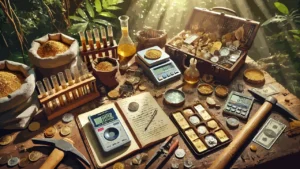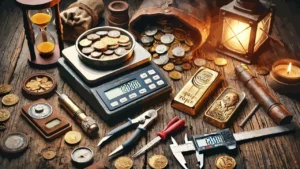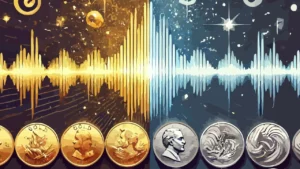Among the many methods for checking gold and silver, the diamagnetism test is the least known even if it is among the most effective. All materials behave differently when they come into contact with a magnet. This very useful behavior is one of the many parameters that allows us to understand if the gold we have in front of us is real or fake.
For silver, however, this test is less significant since fake silver is usually made of copper, which behaves quite similarly to silver when approached by a magnet.
👉 Read also: How to Test Investment Gold and Silver 🎬
Video contents
- (00:00) Introduction and theory
- (07:38) Practical test
- (14:43) Conclusions
#1. Diamagnetism, paramagnetism
In the presence of a magnetic field, materials can exhibit:
- Diamagnetism: also commonly called “non-magnetism” is the property that a material has of magnetizing itself with a very weak force of repulsion inverse to a magnetic field. The force is so weak that a high-precision scale (at least 0.01g) is needed to detect this phenomenon in objects of a few dozen grams in the presence of a neodymium magnet. Some diamagnetic materials: gold, silver, copper, lead.
- Paramagnetism: is the property that a material has of magnetizing itself with a very weak force of attraction in the same direction as a magnetic field. Also in this case, the force is so weak that a high-precision scale (at least 0.01g) is needed to detect this phenomenon in objects of a few dozen grams in the presence of a neodymium magnet. Some paramagnetic materials: tungsten, platinum, palladium, aluminum.
- Ferromagnetism: is the property that a material has to magnetize with a notable force of attraction in the same direction as a magnetic field. Iron and its alloys are almost always ferromagnetic materials.
#2. Application of diamagnetism
Now that we have a rough understanding of these 3 properties, how can we use them to reveal fake gold?
Luckily, gold (along with silver and copper) is a diamagnetic metal while its most fearsome opponent, tungsten, is paramagnetic. As I have shown several times in my videos, tungsten is easily recognizable because of the dull sound it produces when hitting the object it is made of.
However, in some cases, the object we want to check may be enclosed in a plastic package or may not have a high enough surface/thickness ratio to allow us to clearly hear the sound. We must therefore look for any traces of diamagnetism to detect possible fake tungsten.
I have created a table showing the main characteristics of precious metals including magnetic susceptibility (diamagnetism, paramagnetism) so that you can have a clear vision of the different values.
👉 Read also: Parameters for Precious Metal Verification 📊
#3. Diamagnetism check
Ok, let’s get to work! We will need:
- Precision scale (I recommend at least 0.001g precision),
- Magnet holder about 8-10cm high,
- Neodymium magnets.
If you don’t have a way to 3D print the magnet support I created, you can use a layer of polystyrene or anything light and non-magnetic to distance the magnets from the scale, in order not to interfere with the correct functioning.
To start, let’s place our scale on a flat surface and place the support with the relative magnets on top. This support will help create a distance between the parts of the scale susceptible to magnetism and the magnets.
Let’s calibrate the scale and slowly lower our object from above, bringing it as close as possible to the magnets but without ever touching them. Now let’s look at the reading.
- If the value is greater than zero, it means that the overall diamagnetic (repulsive) forces of the object are greater than the paramagnetic ones.
- If the value is less than zero, it means that the overall paramagnetic (attractive) forces of the object are greater than the diamagnetic ones.
If our reading is greater than zero, we can say that the object to be tested has passed the test and is probably real gold. Otherwise, we are probably dealing with an object containing tungsten or another paramagnetic material.
I recommend probing the object in several places so as to be able to verify any disparities in material within it. In any case, never limit yourself to just one test when testing gold, but do all the possible tests as I have shown in this article.
Remember that copper and silver are also diamagnetic, but their density is almost half that of gold and consequently the object would be half as heavy or double in size… in short, the fake would easily catch the eye!
#4. The case of false positives
Although gold, copper and silver are diamagnetic metals, the magnetic behavior of a coin depends not only on the nature of its main components, but also on their interaction. Metal alloys can modify the individual properties of the elements that compose them. Temperature can also play an important role: while pure gold remains diamagnetic at any temperature, some quantum phenomena in alloys can lead to slight alterations in the magnetic response.
It is therefore essential to understand not only the chemical composition, but also the physical context in which a coin is analyzed:
👉 Read also: Metalli Diamagnetici ma che Presentano Paramagnetismo (ITA 🇮🇹 Only)
#5. Small traces of tungsten
Before concluding, I am sure that someone will wonder if this test is able to detect even a small amount of tungsten inside a fake.
Fortunately, the paramagnetism of tungsten is about 2.5 times stronger than the diamagnetism of gold and consequently the amount of tungsten needed to have at least a neutral reading should be 35%. A reading that would in any case raise suspicion. A presence of 17% tungsten would instead make the diamagnetism of gold prevail even with a weakly positive reading.
I feel I can say that a quantity of tungsten up to 10% could go unnoticed by this test but this should not alarm me as I have never encountered fakes with such a small amount of tungsten and in any case they would not pass the sound frequency test.
If you require a more precise check you can use an electrical conductivity tester which however costs at least €800 and personally, at least for investment gold (coins, ingots, bars), I do not consider it at all necessary.








Leave a Reply